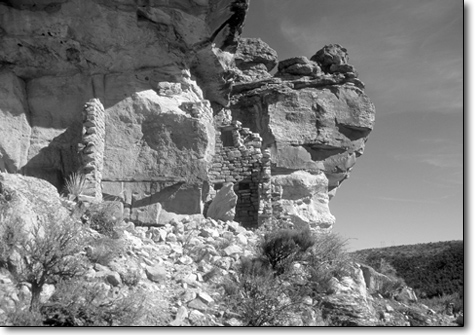|
|
||||
|
Monument tops 'endangered' list Impacts take toll on cash-strapped Canyons of the Ancients SideStory: A look at the National Landscape Conservation System
by Will Sands Off-road vehicles, vandals, and oil and gas development are sending shockwaves through the Canyons of the Ancients National Monument. Their impacts, and the lack of funding to manage them, led to the recent listing of the nearby monument, along with the entire National Landscape Conservation System, as one of America’s most endangered historic places. Located 45 miles west of Durango, the Canyons of the Ancients National Monument encompasses 164,000 acres and represents the highest density of archeological sites in the country, often containing more than 100 sites per square mile. The large area of high desert was designated by a controversial presidential proclamation in June of 2000. Since that time, the Bureau of Land Management has administered the area but largely without a rulebook or substantial budget. The agency is currently working on putting together a management plan for the monument, which it hopes to have in place by the summer of 2006. The absence of the rulebook, along with the prior absence of a monument, have led to carefree use of the land just west of Cortez. Off-highway vehicles in particular have had relatively free rein in the delicate area. As a result, impacts to the archaeological and biological resources are ongoing. The monument is also part of the National Landscape Conservation System, a 5-year-old land conservation system that is managed by the Bureau of Land Management. The NLCS was developed to protect areas like Canyons of the Ancients. However, budgetary shortfall and lack of staffers is hindering that protection. The current situation recently led the National Trust for Historic Preservation to list the Canyons of the Ancients and the entire NLCS on its 11 Most Endangered Historic Places list. “The National Landscape Conservation System was created five years ago to protect some of America’s most extraordinary lands, rivers and cultural sites,” said William Meadows, president of The Wilderness Society. “These places, like Canyons of the Ancients, provide some of the last opportunities to experience the historic landscape of the American West. Inclusion on the 11 Most Endangered list is a wake-up call. We need to act now to protect this vital piece of our American heritage.” There is hope that the “wake-up call” will stimulate interest in the NLCS, which has suffered from lack of funding since its inception “The NLCS has never had the capital to adequately staff itself,” said Amber Clark, public lands coordinator for San Juan Citizens Alliance. “In Canyons of the Ancients, that means not having enough people on the ground to prevent looting and cultural and biological damage or to educate people on those fronts.”
“The NLCS has never had the capital to adequately staff itself,” said Amber Clark, public lands coordinator for San Juan Citizens Alliance. “In Canyons of the Ancients, that means not having enough people on the ground to prevent looting and cultural and biological damage or to educate people on those fronts.” Canyons of the Ancients has been particularly hard hit by vandalism and off-road vehicle traffic, according to Clark. “Looting and ATV use are the biggest culprits,” she said “Looting has been happening in that area for years, and it’s definitely still occurring. OHV traffic is largely unregulated and also leaving its mark.” In addition, mineral exploration has taken a toll on the Canyons of the Ancients. San Juan Citizens Alliance has4 long been critical of the use of 31-ton seismic-testing vehicles known as “thumper trucks” in the area. “There are also impacts from oil and gas development,” Clark said. “Thumper trucks go through areas, leaving wide tracks, and then ATVs come in and assume they’ve found a road.” Great Old Broads for Wilderness and the San Juan Mountains Association are two Durango-based groups that recognized the Canyons of the Ancients crisis long before the recent listing. Great Old Broads director Ronni Egan explained the problem, saying, “There’s an ever-widening spider web of user-created impact that the agency doesn’t have any resources to monitor or enforce. It’s not just a question of soil erosion or wildlife disruption, but of increased access to isolated archeological sites that need to be left alone and protected.” Great Old Broads and the SJMA recently partnered in a grass-roots effort for the sake of the monument’s health. Filling a void left by the BLM, volunteers are going into the monument, documenting existing roads and trails, both legal and user-created, and entering them into a database. “Private sector nonprofits are taking up the slack for a lot of the things the federal government used to take care of in the past,” Egan said. “Unfortunately, tax reform is also drying up a lot of our funding. If the government’s not going to do it, and we’re not getting funding, it’s going to get critical out there.” Clark also concluded that adding some dollars to the situation will be necessary to solve the problem. Unlike the National Park Service, which receives $18 per acre for management, the BLM receives less than $1.70 per acre for national monuments. In addition, funding for Canyons of the Ancients dropped by an astonishing 21 percent in the last year. “The Canyons of the Ancients needs funding to have people on the ground monitoring all of these things,” Clark said. “If we can add funds, I’m not sure we’ll still have a problem.”
|



